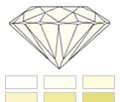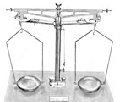Estimating the value of a diamond
Diamonds are normally classified by what is known as "the diamond 4 C '. The combination of these factors is what determines the price of the diamond, and small differences can mean different price pictures. Below is a detailed description of Carat (weight), Color (color), Clarity (clarity) and Cut (Grinding).




CLARITY
Natural diamonds are the result of carbon exposed to tremendous heat and pressure deep in the earth. This process can result in a variety of internal characteristics called 'inclusions' and external characteristics called 'blemishes.'
Evaluating diamond clarity involves determining the number, size, relief, nature, and position of these characteristics, as well as how these affect the overall appearance of the stone. While no diamond is perfectly pure, the closer it comes, the higher its value.
Many inclusions and blemishes are too tiny to be seen by anyone other than a trained diamond grader. To the naked eye, a VS1 and an SI2 diamond may look exactly the same, but these diamonds are quite different in terms of overall quality. This is why expert and accurate assessment of diamond clarity is extremely important.
Category | Grade |
Flawless | FL |
Internally flawless | IF |
Very very slightly included | VVS1, VVS2 |
Very slightly included | VS1, VS2 |
Slightly included | SI1, SI2 |
Included 1 | I1 |
Included 2 | I2 |
Included 3 | I3 |
COLOR
The diamond color evaluation of most gem-quality diamonds is based on the absence of color. A chemically pure and structurally perfect diamond has no hue, like a drop of pure water, and consequently, a higher value. GIA's D-to-Z diamond color-grading system measures the degree of colorlessness by comparing a stone under controlled lighting and precise viewing conditions to masterstones stones of established color value.
GIA's diamond D-to-Z color-grading scale is the industry's most widely accepted grading system. The scale begins with the letter D, representing colorless, and continues, with increasing presence of color, to the letter Z. Many of these color distinctions are so subtle that they are invisible to the untrained eye; however, these distinctions make a very big difference in diamond quality and price.
GIA (USA) | Scan. D.N. | Abbrevation |
D-E | River | R |
F-G | Top Wesselton | TW |
H | Wesselton | W |
I (Com) | Top Crystal | TCr |
J (Com) | Crystal | Cr |
K (Com)-L | Top Cape | TCa |
M-N | Cape | Ca |
O-R | Light Yellow | LY |
S-Z | Yellow | Y |
CUT
Diamonds are renowned for their ability to transmit light and sparkle so intensely. We often think of a diamond's cut as shape (round, emerald, pear), but a diamond's cut grade is really about how well a diamond's facets interact with light.
Precise artistry and workmanship are required to fashion a stone so its proportions, symmetry, and polish deliver the magnificent return of light only possible in a diamond.
A diamond's cut is crucial to the stone's final beauty and value. And of all the diamond 4Cs, it is the most complex and technically difficult to analyze.
Cut grades |
Excellent |
Very good |
Good |
Fair |
Poor |
CARAT
Diamond carat weight is the measurement of how much a diamond weighs. A metric "carat" is defined as 200 milligrams.
Each carat can be subdivided into 100 'points.' This allows very precise measurements to the hundredth decimal place. A jeweler may describe the weight of a diamond below one carat by its 'points' alone. For instance, the jeweler may refer to a diamond that weighs 0.25 carats as a 'twenty-five pointer.' Diamond weights greater than one carat are expressed in carats and decimals. A 1.08 carat stone would be described as 'one point oh eight carats.'
All else being equal, diamond price increases with diamond carat weight, because larger diamonds are more rare and more desirable. But two diamonds of equal carat weight can have very different values (and prices) depending on three other factors of the diamond 4Cs: Clarity, Color, and Cut.
It's important to remember that a diamond's value is determined using all of the 4Cs, not just carat weight.
Diameter 1,3 mm 1,7 mm 2,0 mm 2,2 mm 2,6 mm 2,8 mm 3,0 mm 3,5 mm 3,8 mm 4,0 mm 4,5 mm 5,2 mm 5,5 mm 6,0 mm 6,5 mm 7,0 mm 7,4 mm 8,2 mm 8,5 mm 9,0 mm 9,5 mm 10,0 mm | Height 0,78 mm 1,02 mm 1,20 mm 1,32 mm 1,56 mm 1,68 mm 1,80 mm 2,10 mm 2,28 mm 2,40 mm 2,70 mm 3,00 mm 3,30 mm 3,60 mm 3,90 mm 4,20 mm 4,50 mm 4,80 mm 5,10 mm 5,40 mm 5,70 mm 6,00 mm | Carat 0,01 ct 0,02 ct 0,03 ct 0,04 ct 0,06 ct 0,08 ct 0,10 ct 0,17 ct 0,20 ct 0,23 ct 0,33 ct 0,50 ct 0,67 ct 0,80 ct 1,00 ct 1,25 ct 1,50 ct 2,00 ct 2,30 ct 2,50 ct 3,00 ct 3,45 ct |

Angel's Tears Diamonds
Västmannagatan 69, 113 26 Stockholm
+46 (0) 70 881 04 10
Copyright © 2015
